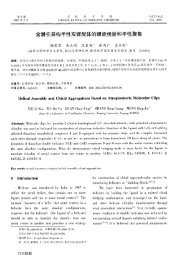Enhance the Optical Absorptivity of Nanocrystalline TiO2 Film with ...
Enhance the Optical Absorptivity of Nanocrystalline TiO2 Film with ...
Enhance the Optical Absorptivity of Nanocrystalline TiO2 Film with ...
You also want an ePaper? Increase the reach of your titles
YUMPU automatically turns print PDFs into web optimized ePapers that Google loves.
High Performance Dye-Sensitized Solar CellsARTICLESTable 1. Detailed Photovoltaic Parameters <strong>of</strong> a “Champion” DSCMade <strong>with</strong> C101 as Sensitizer and Cheno as CoadsorbentMeasured under Different Incident Light Intensities aP in/mW cm -2 J sc/mA cm -2 V oc/mV P max/W m -2 FF η/%29.72 5.42 746.2 33.7 0.833 11.351.17 9.27 761.0 57.4 0.813 11.264.42 11.65 765.9 71.7 0.804 11.199.39 17.94 777.7 109.5 0.785 11.0a The spectral distribution <strong>of</strong> our measurement system simulates AM1.5G solar emission. Incident power intensity, P in; short-circuitphotocurrent density, J sc; open-circuit photovoltage, V oc; maximumelectricity output power density, P max; fill factor, FF ) P max/P in; andtotal power conversion efficiency, η. Cell area tested <strong>with</strong> a metal mask:0.158 cm 2 . The electrolyte composition is as follows: 1.0 M DMII, 50mM LiI, 30 mM I 2, 0.5 M tert-butylpyridine, and 0.1 M GNCS in <strong>the</strong>mixed solvent <strong>of</strong> acetonitrile and valeronitrile (V/V, 85/15).and fill factor (FF) <strong>of</strong> devices A are 18.62 mA cm -2 , 744 mV,and 0.755, respectively, yielding an overall conversion efficiency(η) <strong>of</strong> 10.5%. Consistent <strong>with</strong> <strong>the</strong> decrease <strong>of</strong> IPCE, <strong>the</strong>measured J sc <strong>of</strong> 17.80 mA cm -2 for device B is also lower thanthat <strong>of</strong> device A; in addition, device B has a feature <strong>of</strong> lowerV oc , resulting in a lower power conversion efficiency <strong>of</strong> 9.5%.Considering <strong>the</strong> similar configuration, molecular size, andanchoring mode <strong>of</strong> <strong>the</strong> two sensitizers, we compared <strong>the</strong>ir ratios<strong>of</strong> molar extinction coefficients and <strong>the</strong> absorptivities <strong>of</strong> dyecoatedtitania films, deriving that C102 has a lower surfacecoverage than that <strong>of</strong> C101. This has been fur<strong>the</strong>r confirmedby <strong>the</strong> dark current measurements. The more exposed surfacesdirectly contacted <strong>with</strong> an electrolyte will result in a fastrecombination between triiodide and photoinjected electrons in<strong>the</strong> titania film, probably diminishing <strong>the</strong> charge collection yield.Apart from that a low J sc produces a low V oc , <strong>the</strong> more surfacestates below <strong>the</strong> conduction band edge due to <strong>the</strong> presence <strong>of</strong>more uncovered titania surfaces in <strong>the</strong> C102 case will alsocontribute to <strong>the</strong> measured low V oc related to <strong>the</strong> quasi-fermilevel <strong>of</strong> <strong>the</strong> mesoporous titania film under light.Keeping in mind <strong>the</strong> importance <strong>of</strong> molecular-scale interfaceengineering, 5b,17 we employed cheno as a coadsorbent <strong>of</strong> C101sensitizer at a molar ratio <strong>of</strong> 1/1 in <strong>the</strong> staining solution toimprove <strong>the</strong> device efficiency. As shown in Figure S10, <strong>the</strong>photovoltaic parameters (J sc , V oc , FF, and η) <strong>of</strong> device Cmeasured under <strong>the</strong> illumination <strong>of</strong> AM 1.5G full sunlight (99.39mW cm -2 ) are 17.94 mA cm -2 , 778 mV, 0.785, and 11.0%,respectively. Under various low light intensities, device efficienciesare even higher, up to 11.3%, as listed in Table 1.Obtaining such a high conversion efficiency <strong>with</strong> <strong>the</strong> C101sensitizer by using a relatively thin double layer film (<strong>the</strong>transparent layer is just 7 µm) is impressive compared to areference cell <strong>with</strong> <strong>the</strong> Z907 dye showing a ∼9.0% efficiency.Note that a 12 µm thick titania film was used for a cell <strong>with</strong><strong>the</strong> N719 sensitizer exhibiting an 11.18% conversionefficiency. 4a Fur<strong>the</strong>r efforts to make a DSC ga<strong>the</strong>ring <strong>the</strong> highJ sc <strong>of</strong> device A and high V oc <strong>of</strong> device C toge<strong>the</strong>r are underwayto fully explore <strong>the</strong> maximal efficiency <strong>of</strong> this C101 sensitizer.Due to <strong>the</strong> impossibility in sealing a highly volatile solventsuch as acetonitrile for long-term <strong>the</strong>rmal testing in ourlaboratories, a MPN-based electrolyte was used to evaluate <strong>the</strong>preliminary stability <strong>of</strong> <strong>the</strong> C101 sensitizer under moderate<strong>the</strong>rmal stress and visible-light soaking. The feature <strong>of</strong> MPNlies in its high boiling point, low-volatility, nontoxicity, andgood photochemical stability, making it viable for practicalapplication apart from <strong>the</strong> need for robust encapsulation. Asshown in Figure 4, under <strong>the</strong> standard AM 1.5G full sunlight,photovoltaic parameters (J sc , V oc , FF, and η) <strong>of</strong> device D usingFigure 4. J-V characteristics <strong>of</strong> device D measured in dark and under <strong>the</strong>irradiance <strong>of</strong> AM 1.5G sunlight <strong>of</strong> 100 mW cm -2 . The electrolytecomposition is as follows: 1.0 M DMII, 0.15 M I 2, 0.5 M NBB, and 0.1 MGNCS in MPN.Figure 5. Detailed photovoltaic parameters <strong>of</strong> device D measured under<strong>the</strong> irradiance <strong>of</strong> AM 1.5G sunlight during successive one sun, visible lightsoaking at 60 °C.<strong>the</strong> C101 sensitizer along <strong>with</strong> a low-volatility electrolyte are17.98 mA cm -2 , 746 mV, 0.737, and 9.7%, respectively. Over9% <strong>of</strong> this cell was retained over 96% <strong>of</strong> its initial performance(Figure 5) under both <strong>the</strong> <strong>the</strong>rmal and <strong>the</strong> light-soaking stressfor over 1000 h. This is <strong>the</strong> first time that such a high efficiencyexcitonic solar cell has passed a long-term stability testing.During <strong>the</strong> whole aging process, a small unwanted drop <strong>of</strong> 50mV in open-circuit potential was noted. As we did not observeany change in <strong>the</strong> diffusion and redox overpotentials <strong>of</strong>electrolytes on <strong>the</strong> platinized counter electrode, <strong>the</strong> decrease<strong>of</strong> V oc should be mainly related to <strong>the</strong> surface state variation <strong>of</strong><strong>the</strong> mesoporous film, probably caused by protons in <strong>the</strong>electrolyte that slowly replace <strong>the</strong> surface adsorbed guaniniumand imidazolium cations. The V oc drop could be attenuated byour previously developed cografting protocol to improve <strong>the</strong>compactness <strong>of</strong> <strong>the</strong> hydrophobic monolayer on <strong>the</strong> titaniasurface. 5b The enhancement <strong>of</strong> device fill factor and short-circuitcurrent during <strong>the</strong> initial ∼300 h aging is due to a faster dyeregeneration rate 5a and thus a decrease in charge transferresistance at <strong>the</strong> interface between <strong>the</strong> dye-coated nanocrystalsand electrolyte. This effect is probably due to improved selforganization<strong>of</strong> C101 molecules on <strong>the</strong> surface <strong>of</strong> titaniananocrystals during aging and electrolyte penetration intocavities containing adsorbed dye molecules, where <strong>the</strong> electrolytewas originally not able to access.J. AM. CHEM. SOC. 9 VOL. 130, NO. 32, 2008 10725
















